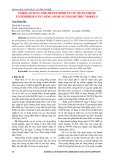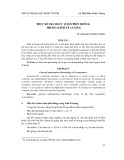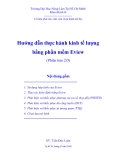
1
1
© Roy Batchelor 2000EVIEWS Tutorial 1
EVIEWS tutorial:
Cointegration and error correction
Professor Roy Batchelor
City University Business School, London
& ESCP, Paris
© Roy Batchelor 2000EVIEWS Tutorial 2
EVIEWS
rOn the City University system, EVIEWS 3.1 is in
Start/ Programs/ Departmental Software/CUBS
rAnalysing stationarity in a single variable using VIEW
rAnalysing cointegration among a group of variables
rEstimating an ECM model
rEstimating a VAR-ECM model

2
2
© Roy Batchelor 2000EVIEWS Tutorial 3
The FT500M workfile
© Roy Batchelor 2000EVIEWS Tutorial 4
Data transformation
rGenerate a series for the natural log of the FT500 index (lft500)
rTest for stationarity in
–the level of this series
–the first difference of this series (dlft500)
rResults show that lft500 is an I(1) variable

3
3
© Roy Batchelor 2000EVIEWS Tutorial 5
Generate ln(FT500)
© Roy Batchelor 2000EVIEWS Tutorial 6
Augmented Dickey-Fuller (ADF) Test

4
4
© Roy Batchelor 2000EVIEWS Tutorial 7
ADF results: level
The hypothesis that
lft500 has a unit root
cannot be rejected
The hypothesis that
lft500 has a unit root
cannot be rejected
© Roy Batchelor 2000EVIEWS Tutorial 8
ADF test results: first difference
The hypothesis that
the first difference of
lft500 has a unit root
can be rejected.
So lft500 is I(1)
The hypothesis that
the first difference of
lft500 has a unit root
can be rejected.
So lft500 is I(1)

5
5
© Roy Batchelor 2000EVIEWS Tutorial 9
Cointegration: two variables
rThe variables lft500 (log of stock index) and ldiv (log of
dividends per share) are both I(1)
rWe can test whether they are cointegrated
–that is, whether a linear function of these is I(0)
–An example of a linear function is
lft500t = a0 + a1ldivt + ut
when ut = [lft500t - a0 - a1ldiv] might be I(0)
rThe expression in brackets [] is called the cointegrating vector,
which has normalised coefficients [ 1, -a0 , -a1 ]
© Roy Batchelor 2000EVIEWS Tutorial 10
Form new group ...









![Tài liệu học kinh tế lượng [mới nhất]](https://cdn.tailieu.vn/images/document/thumbnail/2013/20130423/sonlam_gst/135x160/6461366717688.jpg)
















